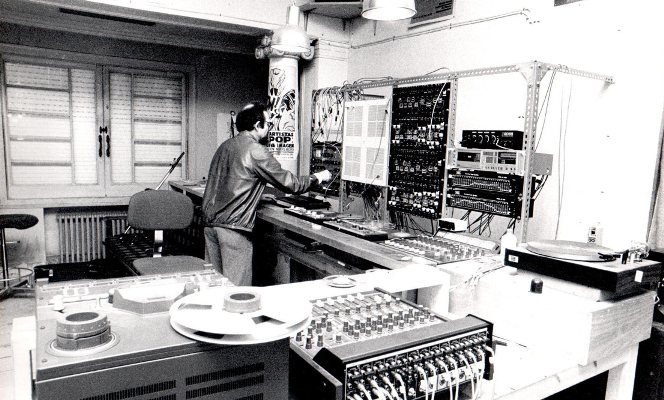El Sindicato de Altavoces: obres de L. Callejo, J.A. Moreno Sánchez, D. Mormeneo, O. Rombau
El Sindicato de Altavoces: obres de L. Callejo, J.A. Moreno Sánchez, D. Mormeneo, O. Rombau
Tuesday, March 12th, 2024 at 20h. Sala Aranyó (UPF Campus Poblenou). Free entry.

EL SINDICATO DE ALTAVOCES
Curator: Pablo Fredes
Program
Lluis Callejo: A Pitàgoras en re
Joan Moreno Sanchez: Essències / Sons
David Mormeneo: Bel·ligerància
Octavi Rumbau: Quiet canon for 16 speakers (homenaje a J. Tenney)
About the composers and pieces:
Lluís Callejo i Creus (Villafranca del Panadés, 1930 — Barcelona, 1987).
Industrial Engineer. Between 1948 and 1955 his musical activity was mainly focused on the direction of choral formations. One of the founders of Phonos, he designed and built several instruments for the production of synthetic sound (the first of which was a synthesizer of random sounds that was called Stokos 4). He was a professor of Information Theory and Systems Dynamics at the UAB and the UPC. At Phonos he dedicated himself to research in digital sound generation and computer-aided composition. He has been teaching music computer courses since 1982.
A Pitàgores en re
It is one of his posthumous works using the combination of a digital sound generator with a Rockwell AIM 65 microprocessor and the Sithi AKS as a timbre generator.
Joan Antón Moreno Sánchez
Composer and pedagogue. He furthered his studies in composition and analysis and techniques of electronic music with Gabriel Brncic. In addition to attending different courses and seminars with Lluís Callejo, Luigi Nono, Horacio Vaggione, Dieter Schnebel. In 1991 he received a commission from the Cabinet of Electroacoustic Music of Cuenca where he composed the work "El hombre sin atributos" and "Buenache". He has composed music for several films.
Essències / Sons
Progressively turning the sound elements that nature gives us into music is the best way to enrich musical creation and also man (in this regard, it should be noted that an instrument made of bamboo cane is as natural as a sinusoid generator).
David Mormeneo
(1998) Studied Composition at ESMUC (2020-2024). He applies musical creation in the fields of staging using new technologies, collaborative and interdisciplinary creation and the hybridization of music with other disciplines, always giving relevance to the dramaturgy of sound. He has participated in various theatrical projects as a musical performer and creator of sound spaces.
Bel·ligerància
The piece is conceived as a dreamlike soundscape that represents the memory of an agitated crowd in the face of the imminence of war. He takes the sea and the nautical world as a sound universe, intertwining bias with oceanic horror and transforming its memory into a shipwreck, stranded in the confines of memory.
Octavi Rumbau
Classically trained pianist, he began his studies in Composition in Barcelona with Enric Palomar and Agustín Charles. Later, he moved to Paris to continue his training at the École Normale de Musique with Yoshihisa Taïra (2001/2004) and, subsequently, at the Conservatory of Music and Dance of Paris (CNSMDP) winning the Composition Award with Frédéric Durieux and Orchestration with Denis Cohen (2007/2012). At the same time, he takes the 1st annual course of music informatics at IRCAM. He is currently a professor in the composition department of the Liceo Conservatory. He was a guest composer at the Auditori de Barcelona during the 2017/2018 season. In 2021 he was awarded the Reina Sofía Prize.
Quiet canon for 16 speakers (homenatge a J. Tenney)
This piece for 16 speakers is a modest tribute to the American composer James Tenney. The basic concept for the construction of the work is based on Tenney's well-known tribute to Conlon Nancarrow "Canon spectral" for mechanical piano. In the case of my work, I use the same concept that Tenney uses in his work, which consists of strictly transposing the frequency intervals of a spectrum into durations of time in order to organize the entire canon, but, in my case, enhancing the timbral dimension through references to chillout music in an enveloping space where each of the speakers represents each of the 16 voices of the canon.
Supported by:

